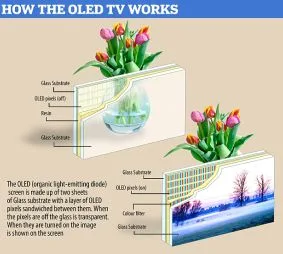In recent years, TV brands have struggled mightily to develop innovative features and advanced capabilities as a means to differentiate their products and capture market share. As might be imagined, many of these features and capabilities are based on the implementation of new technologies. Examples of this include 4K resolution, curved screens, dynamic backlights and 3D. This article reports on one of Panasonic’s efforts in this regard: a TV that is transparent until such time as it is turned on.
A version of Panasonic’s transparent TV technology was presented last January at the CES show. Meko discussed this prototype in an event report which is available on-line (subscription required). The report was accompanied with a video that shows the prototype in operation. The video can be found here.
The CES prototype TV was based on an LCD. The TV also seems to have included a liquid crystal shutter behind the LCD that acted as a switchable black background. The shutter was needed because a transparent LCD cannot by itself produce an image with a black background. Although a very eye catching exhibit, one problem with the CES prototype was insufficient image brightness. Despite using under shelf lighting to enhance image brightness, the image presented by the display was reported as looking dim in comparison to its surroundings. In the clear state, the Panasonic TV had a transparency of about 11% making it noticeably different from, for example, a simple glass window.
Panasonic has now shown a transparent TV based on an OLED display. The company presented the TV at IFA and also at the the Ceatec Japan 2016 conference held between October 4th and 7th.
The latest version of the transparent TV is reported as easier to read and brighter than the CES prototype but…..the best image quality is still obtained when the transparent TV is used in a dim environment. In the transparent state, the TV is now described as being ‘as clear as a glass panel’. The conclusion that can be drawn is that the transparent TV should be ready for use in most home environments.
The display is made using fine OLED “wires” that are embedded between the glass substrates. This OLED mesh is sufficiently fine that it is not apparent when the display is in its’ transparent off mode. Having said that, a viewer inspecting the prototype from close up can still see a very fine grid.
A graphic included in a Daily Mail.com on-line article illustrates the configuration of the transparent display and can be found below.
It is unlikely that Panasonic produced the transparent OLED display component used in the TV since the company stopped in-house large area OLED development in 2013. It’s possible that Panasonic is using displays made by LGD, as is the case in the company’s commercial OLED TV products, but it may also be from Samsung which was, for a short while, in production of transparent OLEDs.
When Panasonic’s transparent TV technology is ready for commercialization, which is not expected for several years, it could find applicability in a variety of new applications. As an example, the TV could be integrated into existing furniture allowing space within a room to be utilized more efficiently. This application is illustrated in the photo below.

Other examples of uses for transparent displays are presented in a video that can be found at the end of this article. One interesting potential application, not discussed in the video, is as a windshield wide heads up display.
Transparent TV technology seems like a clear winner. Display Daily readers can count on Meko to report on future developments. -Arthur Berman
Analyst Comment
At both IFA and CES, consumers were very excited by the design prospects of this kind of TV. I have heard TV designers say that consumers don’t like the ‘black hole on the wall’ and TV makers have been playing with the idea of transparent TVs for some years – I remember Loewe won a design award for one concept.
On the question of transparent windscreen displays, there are several barriers. At the moment, legislation mandates a minimum transparency of windscreens and that will be a real challenge for embedded displays. That could change, of course, with the arrival of autonomous cars or cars universally equipped with cameras. The second problem is an optical one. It seems that the pattern of transistors needed to drive the display effectively acts as a diffusion grating and means that it is hard to get a good view of objects that are at some distance from the display. This is, apparently, why most demonstrations of transparent displays have the displayed object close to the display itself, as was the case with the Panasonic demo.
Finally, car windscreens are made of not very accurate and very cheap glass. The cost of a 3D transparent display that could also meet safety needs would be very expensive.
As we have reported in our subscription newsletters, Lumineq, the EL company in Finland is developing in windscreen technology for industrial and agricultural vehicles. (BR)

